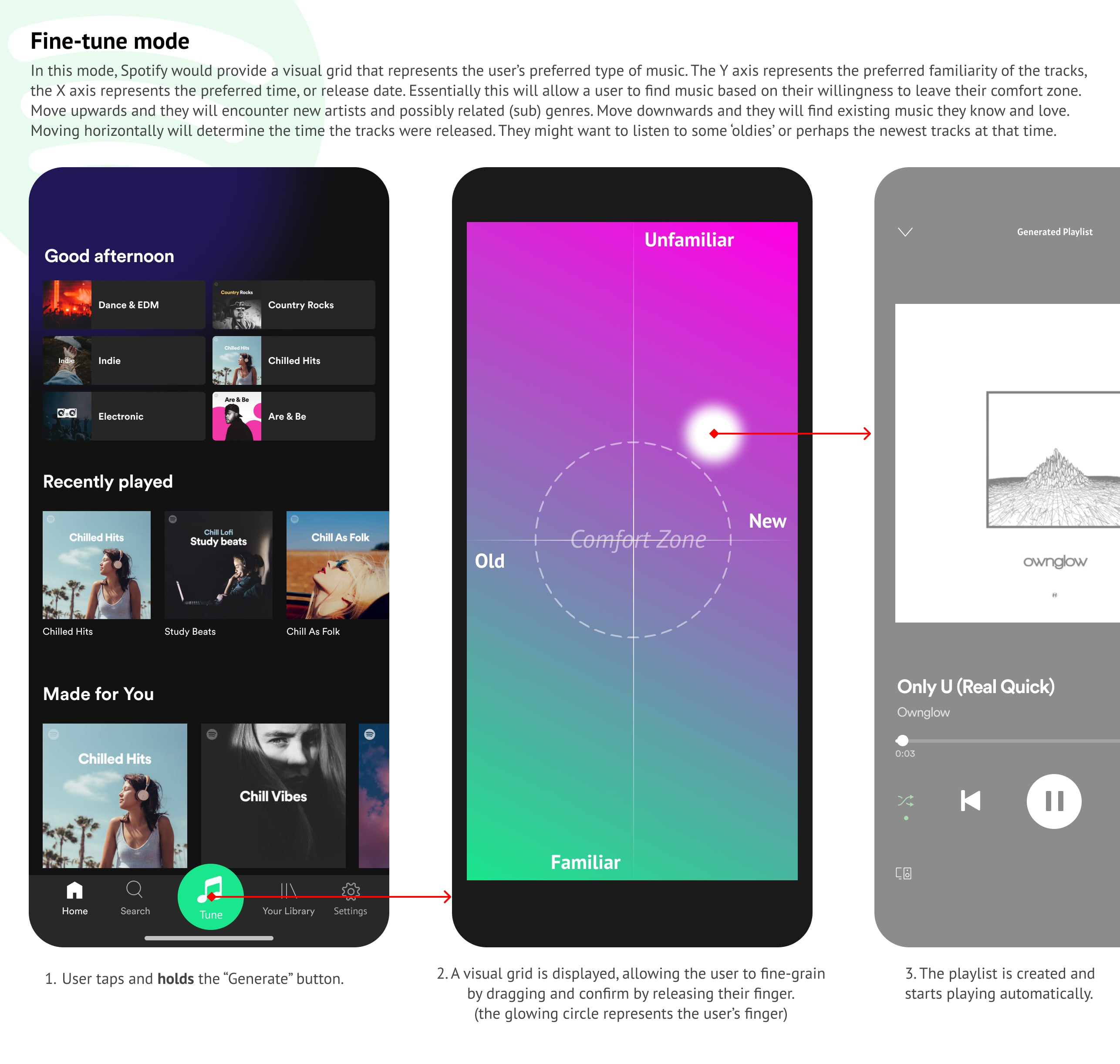Spotify Playlists
It's remarkable how often I just want to turn on the music, similar to what we expect from the good old-fashioned radio. However, streaming platforms such as Spotify have changed the game, allowing us to tune into specific genres, moods, and activities. Yet, when browsing through the genres, it's hard not to notice that most of these playlists are managed by Spotify themselves.
Despite countless user-managed playlists, Spotify seems to prioritize their own, dubbed "editorial playlists". Managed by Spotify's own "cultural experts", their exact qualifications remain a mystery. This left me wondering why Spotify hasn't embraced the idea of a community more. Are users unable to keep up with managing extensive playlists? Does Spotify want to ensure consistent quality? Or, perhaps they want to prevent third parties from controlling this part of their ecosystem.
Considering Spotify's leading position in the music streaming industry, the way they design and manage their app affects a significant number of people. With a large audience comes ample monetary opportunities, especially for artists. Suddenly finding yourself featured on a popular playlist can skyrocket your visibility, resulting in a flood of royalties and exposure. This isn't a hypothetical scenario; it's the real impact of being featured in playlists.
This suggests that the idea of "playlist hijacking", as I like to call it, is not be as implausible as one might think. Eager to seize the opportunity, bad actors would be tempted to curate popular playlists in order to assert control over tracks and artists. While there would be costs involved for the artist, the return on investment would make it worthwhile. While merely a hypothesize, it seems the only thing stopping it from becoming a reality is Spotify’s efforts to out-perform it.
Another article discussing this very topic suggested how the system is self-regulating: if a song is of low quality, it will be skipped, and the artist won't get paid, thus discouraging people from leveraging playlists for financial gain. However, this analysis might overlook a gray area. There are plenty of mediocre tracks that aren't terrible enough to be skipped immediately, especially when used as background music in public spaces. It might not be the greatest track in the world, but it's usually not bad enough to prompt a 'next' click. This suggests that there is indeed room for the system to be manipulated, allowing artists to pay for placements on playlists.
This may clarify Spotify's motive for asserting more control to prevent misuse of their platform. However, it raises questions about whether it's somewhat contradictory, or even hypocritical, to enforce musical preferences on users to prevent others from doing so. It appears to signify a lack of trust in their users and can leave them feeling generalized and undervalued. But more importantly, it highlights an obvious design flaw in their application, one that has essentially forced them into this position in the first place. Ironically, they seem to be curating playlists not out of choice, but out of necessity.
While I don't have a perfect solution to this issue, a few years ago I developed this idea to enable the creation of highly personalized playlists through a visual grid. This grid would consider two music aspects: release date and familiarity, where its center represented the user's comfort zone. I named this feature "Tune" and included both "fine-tune" and "auto-tune" modes, as depicted in the screenshots below and its design document. This approach could offer a new way for users to enjoy their music while giving them more control and a sense of ownership over their listening experience. While not taking into account preferences for genre, one could imagine a similar solution.
 My proposal for a new "Tune" feature.
My proposal for a new "Tune" feature.Netflix's mini-series, The Playlist, a tribute to the rise of Spotify and the story of its founders, paints an intriguing picture of their vision for the future of music. They aimed to democratize music for creators and listeners, freeing them from the clutches of profit-driven production labels. But ironically, Spotify seems to have assumed a similar role by controlling what makes it into their playlists. They may argue it's for ensuring quality and relevance, but isn't that what music labels used to say? If Spotify genuinely cared for its users' interests, they would refrain from dictating our music choices and instead foster a naturally evolving ecosystem within a well-designed environment.
To be honest, I have had my issues with Spotify for a few years now. While I won't delve into why their application doesn't suit my needs, this playlist issue is one of my main concerns. It seems like Spotify has lost sight of its core values, focusing more on profit, as demonstrated by the recent price hike of their Family membership from €15 to €18. This decision feels particularly unfair to the loyal users who have supported them from the start (myself included, as a member since around 2012).
The state of affairs suggests that now might be the time to consider alternatives to Spotify. However, with Spotify holding most of the cards in terms of music availability and software/hardware support, it seems unlikely that they will be eclipsed by a competitor any time soon. But who knows? The landscape of music streaming is ever-changing, and perhaps a new contender will step up to challenge the status quo.